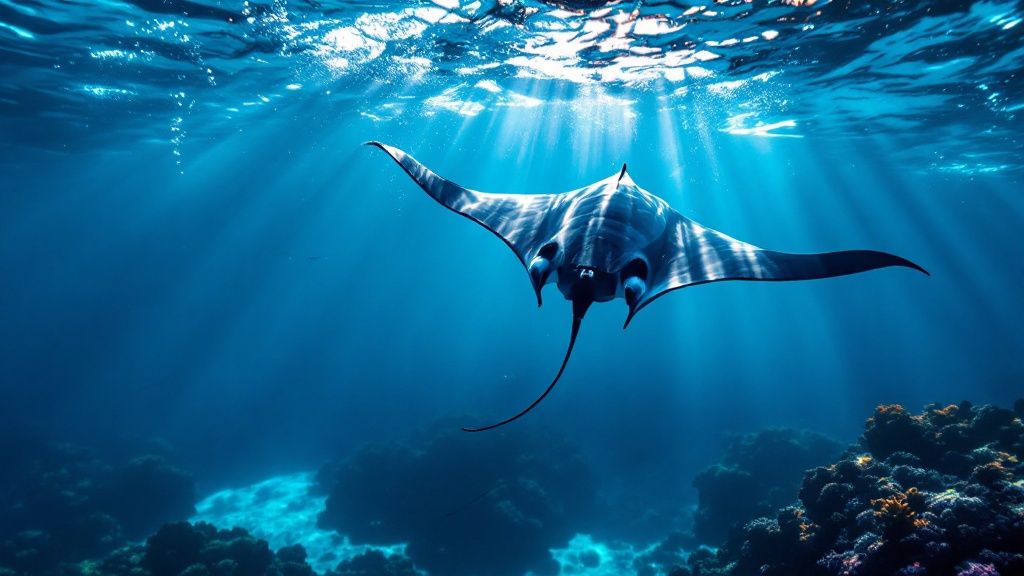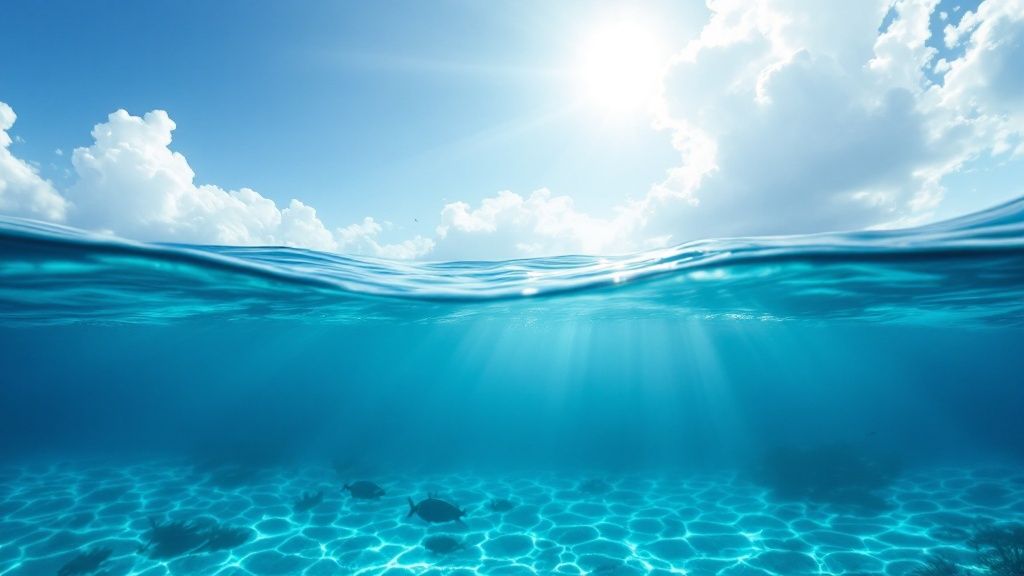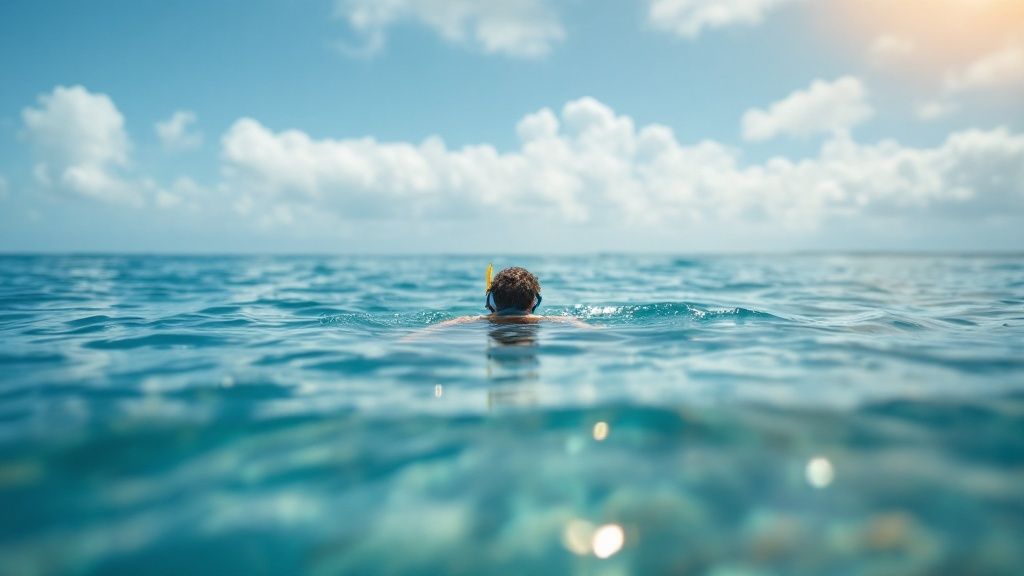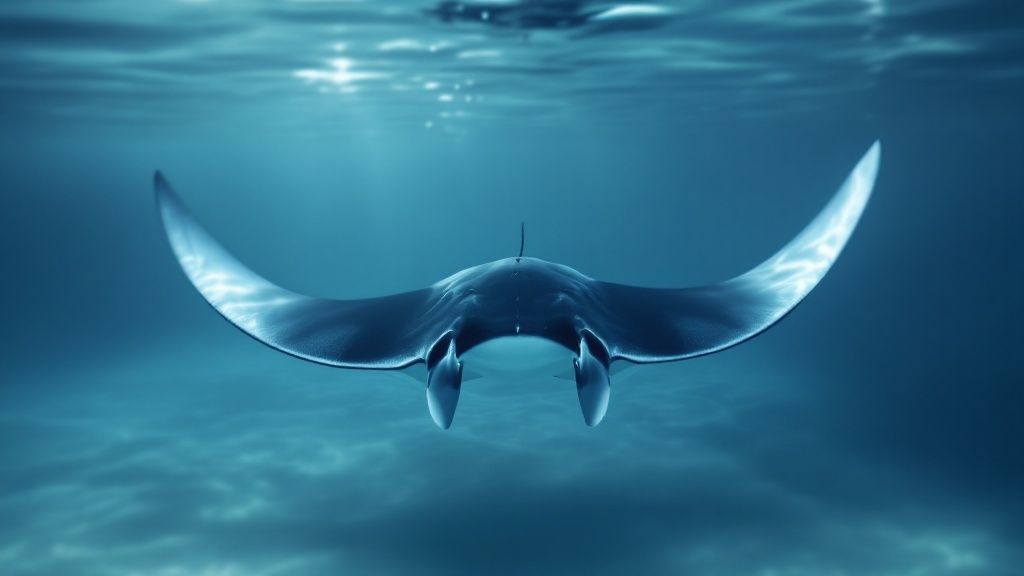Manta Ray Snorkeling Kona: Unforgettable Encounters
- Byron
- Mar 9
- 11 min read
Why Manta Ray Snorkeling Kona Tops Travel Bucket Lists

Manta ray snorkeling in Kona, Hawaii, is a truly unforgettable experience, consistently earning a top spot on travelers' bucket lists. What sets this experience apart? It's the unique combination of factors that make Kona a haven for these gentle giants. The volcanic slopes and shelves off the Kona coast create the ideal environment for manta rays to flourish.
These underwater formations, coupled with nutrient-rich currents, attract an abundance of plankton, the manta rays' primary food source. These currents carry microscopic organisms to the surface, providing a nightly feast that draws manta rays in large numbers.
The Nightly Ballet of the Manta Rays
Tour operators use specialized lights to amplify this natural phenomenon. These lights create an illuminated underwater ballet as the mantas perform acrobatic backflips to feed on the plankton. This reliable food source contributes to exceptionally high sighting rates, often between 80-90% year-round. This means visitors have a very high probability of encountering these magnificent creatures, no matter the season.
Manta ray snorkeling in Kona is incredibly popular, attracting approximately 80,000 participants annually. It's one of the most sought-after wildlife experiences in Hawaii. This popularity stems from the consistent manta ray sightings. Find more detailed statistics here.
The Cultural Significance of Manta Rays in Kona
Beyond the remarkable spectacle, the cultural significance of manta rays in Hawaiian heritage adds another layer of richness to the experience. Revered for their grace and intelligence, mantas hold a special place in local folklore and traditions. This cultural aspect transforms your manta ray snorkeling adventure in Kona from a simple sightseeing trip into a truly meaningful encounter. It's a chance to connect with the deep-rooted respect for these creatures within Hawaiian culture.
The Kona Advantage: Consistent Sightings
Not all manta ray viewing locations are equal. While other destinations might offer occasional glimpses, Kona stands out for its consistent sightings. Kona's unique ecosystem supports large, healthy manta ray populations. The combination of a consistent food supply and careful conservation efforts makes this possible. For a guaranteed close encounter with these gentle giants, manta ray snorkeling in Kona is unmatched. You can find more details on our sitemap.
This reliable visibility, combined with the chance to observe these creatures in their natural environment, makes manta ray snorkeling in Kona truly exceptional.
Getting to Know Kona's Magnificent Ocean Giants

Beyond the thrill of manta ray snorkeling in Kona, lies a deeper understanding of these graceful creatures. Learning about their biology and behavior truly enriches the entire experience. Each manta ray, for instance, has unique spot patterns on its underside, much like fingerprints.
These markings allow researchers to identify individual mantas and track their movements. This adds a personal touch to each Kona manta ray snorkeling adventure, knowing you're observing a unique individual in its natural habitat.
Manta Ray Intelligence and Social Behavior
Manta rays are incredibly intelligent animals. Their large brain-to-body ratio suggests a significant capacity for complex thought and social interaction. This intelligence is visible in their coordinated feeding behaviors and how they engage with divers and snorkelers.
This high level of intelligence distinguishes them from many other fish species. A manta ray snorkeling trip in Kona offers a fascinating glimpse into this underwater world of intelligence and social dynamics.
The Kona Coast is a remarkable haven for both reef manta rays (**Mobula alfredi**) and the giant oceanic manta ray (**Mobula birostris**). While the giant manta ray can boast wingspans up to 26 feet, the reef manta ray is more frequently seen on snorkeling excursions.
These rays hold cultural significance in Hawaii, even appearing in the Hawaiian creation chant, the kumulipo. Discover more insights about Hawaiian manta rays. This cultural connection adds another layer of depth to the manta ray snorkeling experience in Kona.
Feeding Techniques and Tracking
Over millions of years, manta rays have developed specialized feeding techniques. Their cephalic fins, positioned near their mouths, act as funnels, guiding plankton-rich water directly into their mouths. While feeding, they often perform captivating backflips and barrel rolls, creating a truly mesmerizing spectacle.
Researchers employ various methods to track the movements of these gentle giants. Tagging programs and photo identification provide scientists with valuable data to understand migration patterns and population dynamics. This information is crucial for effective conservation efforts.
Every manta ray snorkeling experience in Kona contributes to the broader understanding and protection of these magnificent creatures. By choosing this activity, you're supporting responsible tourism and helping to preserve these animals for generations to come.
Timing Your Perfect Manta Ray Encounter

Planning a manta ray snorkeling adventure in Kona is more than just booking a tour; it's about choosing the right time to maximize your experience. Understanding the seasons, moon phases, and daily conditions can significantly impact your viewing success. This is why experienced guides carefully monitor the ocean's rhythm to predict the best viewing nights.
Manta ray snorkeling tours in Kona are available all year. However, the dry season, from April to October, typically offers the best viewing conditions. The calmer, clearer waters during the summer months dramatically improve visibility, enhancing your overall manta ray snorkeling experience. Even outside these peak months, tours continue, often with unique options like traditional Hawaiian canoe tours or specialized photography services. Choosing the right tour operator can elevate your trip. Factors like group size and eco-conscious practices contribute to a memorable and sustainable experience. Learn more about planning your Kona manta ray experience here.
The Influence of the Moon and Tides
The moon significantly influences manta ray behavior. The lunar cycle impacts plankton concentration, the manta rays' primary food source. A full moon often means higher plankton availability near the surface, attracting more manta rays to feeding areas. Understanding this connection lets you time your excursion for the best chance of an unforgettable encounter.
Tides also matter. Incoming tides can bring clearer water and denser plankton, creating ideal feeding conditions. For the best manta ray snorkeling experience, consider scheduling your tour around these tidal shifts.
Kona's Hotspots: Manta Village and Garden Eel Cove
Kona has several renowned manta ray viewing locations, each with unique characteristics. Manta Village, a shallow area with a sandy bottom, is especially popular. Its topography creates a natural amphitheater for observing these graceful creatures. Garden Eel Cove, while not exclusively for manta rays, sometimes offers sightings along with its resident garden eels. This provides a unique dual viewing opportunity.
Weather and Water Clarity: Key Factors
Water clarity is essential for a successful manta ray snorkeling experience. Calm seas and minimal rainfall contribute to optimal visibility. Checking local weather forecasts will help ensure a clearer view of these majestic creatures. Experienced guides have local knowledge of weather patterns and water clarity factors to enhance your chances of a memorable encounter.
The following table provides a seasonal guide to help you plan your trip.
To help you choose the best time for your snorkeling adventure, we've compiled the following seasonal comparison:
Seasonal Guide to Manta Ray Snorkeling in Kona
Season | Water Conditions | Visibility | Crowd Levels | Manta Ray Activity |
|---|---|---|---|---|
Winter (November - March) | Can be rougher seas; more rain | Moderate to lower | Lower | Consistent, but can be affected by weather |
Spring (April - May) | Transitioning to calmer conditions | Increasing | Moderate | Increasing activity |
Summer (June - September) | Calmest seas; less rain | Highest | Highest | Peak activity |
Fall (October - November) | Transitioning to winter conditions | Decreasing | Moderate | Still active, but starting to decrease |
As you can see, each season offers a different experience. While summer boasts the best visibility and highest manta ray activity, it also has the largest crowds. The winter months offer a quieter experience, but with potentially compromised viewing conditions. Choosing the right season depends on your priorities.
Selecting Your Ideal Manta Ray Experience

With so many tour operators offering manta ray snorkeling excursions in Kona, choosing the right one can be overwhelming. This guide, drawing from research and reviews, helps you navigate the options and find an experience that truly suits you. Picking the right tour is essential for an unforgettable Kona manta ray adventure.
Group Size: Intimate Encounters or Bustling Crowds?
Group size is a critical factor. Smaller groups generally mean more individual attention from the guide and a less congested viewing area. A six-person group, for instance, allows for closer encounters and more chances to ask questions.
Larger groups might be cheaper, but they often feel less personal. You might have limited interaction with the guide and obstructed views of the manta rays. The best manta ray snorkeling Kona experience is often found in smaller, more intimate settings.
Boat Design: Comfort and Viewing Platforms
The boat's design significantly affects your comfort and viewing opportunities. Some boats boast spacious viewing platforms, making it easy to enter and exit the water. This is particularly helpful for those less comfortable in the ocean.
Other boats might be smaller and offer a more intimate setting, though they might be less stable. Consider what you value most during your manta ray snorkeling Kona tour: a large, stable platform or a smaller, cozier boat.
Questions to Ask: Ensuring a Responsible Experience
Don't hesitate to ask potential tour operators questions. Inquiries about safety protocols, guide experience, and conservation efforts reveal their priorities. Asking about their manta ray interaction procedures, for example, shows your commitment to a responsible experience. Another key question is about group sizes, as this directly impacts your viewing experience. Reputable operators will be transparent about their practices.
To help you compare different tour operators, take a look at the table below:
Manta Ray Tour Operator Comparison A detailed comparison of tour options to help readers choose the right manta ray snorkeling experience for their needs.
Tour Type | Typical Group Size | Duration | Inclusions | Best For | Price Range |
|---|---|---|---|---|---|
Small Group Sunset Tour | 6-8 | 2 hours | Snorkel gear, wetsuits, hot drinks | Those seeking a personalized experience | $150-$200 |
Large Group Sunset Tour | 20-30 | 1.5 hours | Snorkel gear, flotation devices | Budget-conscious travelers | $90-$120 |
Private Charter | Customizable | Customizable | Customizable | Families or small groups seeking exclusivity | $500-$1000+ |
Photography Focused Tour | 8-12 | 2.5 hours | Snorkel gear, underwater camera rental, photography tips from the guide | Photography enthusiasts | $180-$250 |
This table highlights the key differences between various manta ray snorkeling tours available in Kona. From intimate small group tours to larger, more budget-friendly options, and even specialized photography tours, there's an experience to suit everyone's needs and preferences. Consider your priorities and choose the tour that best fits your budget and desired level of interaction.
Budget vs. Premium: Understanding the Value
Price often reflects the quality of equipment, the guide’s expertise, and the operator’s commitment to sustainability. Budget tours may offer lower prices, but often with larger groups and less personalized service.
Premium experiences may include high-quality wetsuits and snorkel gear, designed for comfort and clear viewing. Experienced guides enhance your trip with insightful commentary and ensure responsible manta ray interactions. Some premium operators even contribute to manta ray research and conservation, adding further value to your choice. Understanding what each price point entails is essential when choosing your Kona manta ray snorkeling trip.
Essential Safety Practices for Underwater Encounters
A manta ray snorkeling Kona adventure offers more than just a glimpse of these magnificent creatures. It's about fostering a safe and respectful interaction for both you and the mantas. Decades of experience have allowed guides to develop important safety protocols that minimize risk and enhance the enjoyment of your manta ray snorkeling Kona excursion. This expertise translates into a secure and enriching experience for all.
Staying Comfortable in the Ocean at Night
For many first-time snorkelers, the idea of a nighttime ocean excursion can be a little daunting. However, with adequate preparation and expert guidance, a manta ray snorkeling Kona trip can be a truly tranquil and rewarding experience. Simple breathing exercises can help manage any pre-trip jitters and encourage relaxation once you're in the water. Combined with proper floatation techniques, these practices will conserve your energy and improve your comfort throughout your manta ray snorkeling Kona adventure.
Maintaining a horizontal body position while floating also helps conserve energy and facilitates easier breathing. This relaxed posture allows you to fully appreciate the wonders of the marine environment without unnecessary exertion.
Respectful Manta Ray Interactions
Proper positioning is essential for both your safety and the well-being of the mantas. Keep a respectful distance and refrain from touching or chasing these gentle giants. Remember, you're a visitor in their natural habitat during your manta ray snorkeling Kona tour. Simply relax, observe, and marvel at these amazing creatures as they glide effortlessly through the water.
It's also important to be aware of changing ocean conditions. Your guide will provide instructions on how to respond to shifts in currents or visibility. Heeding these signals is key to a safe and comfortable manta ray snorkeling Kona experience and ensures a positive encounter for everyone involved.
Practical Preparation and Equipment
Before embarking on your manta ray snorkeling Kona adventure, take some time to review the provided safety briefing. Familiarize yourself with the equipment, including the correct use of your snorkel and mask. Proper preparation builds confidence and enhances your comfort level in the water. If you're new to snorkeling, consider practicing in a pool or shallow water before your tour.
Selecting a responsible tour operator is another critical factor for a safe and enjoyable experience. Look for operators committed to sustainable practices and small group sizes. A safety assessment for manta ray viewing operations in Kona highlights the importance of managing the growing number of participants and vessels. Although serious accidents are relatively rare, the increased volume of activity does elevate the potential for incidents.
Currently, there are no effective capacity controls in place, despite the escalating demand for these tours. This underscores the importance of choosing a responsible operator dedicated to safety and sustainability. You can check out our sitemap information for more details. With careful planning and the right operator, your manta ray snorkeling Kona experience will be both safe and truly unforgettable.
Being Part of Manta Ray Conservation Success
Your choices as a visitor directly impact the future of manta ray populations and their habitat. Manta ray snorkeling in Kona provides an incredible opportunity to witness these magnificent creatures and contribute to their protection. Maintaining this balance between tourism and conservation is crucial for ensuring these animals thrive.
Tourism and Research: A Powerful Partnership
Manta ray snorkeling tours in Kona offer a unique platform for research and conservation. Many operators actively collaborate with marine biologists and contribute data gathered during tours. This partnership provides valuable insights into manta ray behavior, movement patterns, and population dynamics.
For example, some operators use photo identification to track individual manta rays, contributing to long-term population studies. This detailed information helps researchers understand the complex lives of these gentle giants.
Educating Visitors About Conservation
Many tours also incorporate educational components, informing guests about manta rays and the importance of their conservation. This fosters a deeper understanding and appreciation, promoting responsible interactions during manta ray snorkeling excursions. Educated visitors are more likely to become advocates for these incredible animals.
Citizen Science: Contributing to Conservation
Citizen science initiatives empower visitors to actively participate in manta ray conservation. Some Kona operators encourage guests to submit photos of manta ray spot patterns for identification and tracking. This data helps researchers monitor populations and understand their movements.
By participating, you directly contribute to conservation, making your Kona snorkeling experience even more meaningful. Consider exploring various blog categories related to marine life and conservation for more ways to get involved.
Supporting Conservation Through Responsible Tourism
Choosing a responsible manta ray snorkeling operator in Kona is a powerful way to support conservation. Some operators dedicate a portion of their proceeds to fund research and conservation programs. Selecting these operators directly contributes to the protection of manta rays.
Look for operators who prioritize sustainable practices, like minimizing their environmental impact and adhering to strict guidelines for manta ray interactions. Informed choices transform your Kona adventure into a force for positive change.
Understanding the Threats to Manta Rays
Manta rays face several threats, including fishing pressure and microplastic pollution. Understanding these challenges is crucial for informed decision-making and responsible behavior during your Kona trip. Fishing entanglement is a significant problem.
By avoiding touching or disturbing the mantas, you minimize the risk of accidental entanglement. Microplastic pollution is another rising concern. Manta rays filter feed, potentially ingesting microplastics. Reducing your plastic consumption and supporting sustainable businesses helps lessen this threat.
A successful Kona manta ray snorkeling experience isn't just about witnessing these animals—it's about contributing to their future. Book your adventure today with Manta Ray Night Snorkel Kona Hawaii Tours and be part of the solution. Experience the magic while contributing to their continued survival. Our tours offer small groups, experienced guides, and a commitment to sustainable practices, ensuring a unique and responsible experience.
Comments